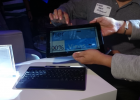Microsoft Windows phones 7.0 were released less than a year ago, but somehow the number of users remains low as consumers still opted to go for Android run smartphones and the iPhone, which at the moment are seeing mercurial rise in number or usage globally.
The platform intended for touch device was still new (Microsoft made the new software from the ground up) and needed more fine tuning for some stuff such as its inability to multitask, copy and paste, or the camera couldn’t be accessed by some applications in network connections.
But now the Windows phone 7.5 makes an appearance, boasting of new power and features and undoubtedly reinforced the idea of a tile format UI called the Metro UI is better alternative than the widgets arranged in a grid espoused by Android and the iPhone.
Samsung, LG and HTC have already come out with Windows 7.5 phones, which offer a new and exciting approach to smartphone experience.
Windows Phone 7.5, codenamed “Mango” offers a number of new features and experiences designed to build on the phone’s intuitive “people-first” foundation, according to Jason Lim, Windows general manager, Microsoft APAC.
Apart from running simultaneous applications, the Windows 7.5 smartphone features more integrated apps, mobile web browsing, and powerful personalization tools, like integrated social networking and conversation threads that connect people and their experiences according to Lim. He said the new version has “more than 500 new features and enhancements to deliver smarter and easier communications, apps and Internet experiences.”
The Metro UI or “Live Tiles” format of Windows Phone is a key difference from other smartphones as each tile isn’t made to be just another application launcher. Each tile or “Hub” combines data from different services that make sense to the user.
The tile format is a more organized way of accessing app or services as the user does less searching, unlike in an Android or iPhone, where apps or widgets get cluttered, particularly when the user is in the habit of downloading more applications.
For example, the “People Hub” offers an integrated view of all your contacts from Facebook, Twitter, Windows Live, Exchange, Gmail and Yahoo as well as updates from your social network friends. So it just doesn’t function as a place to look for a friend’s number, but also a place you go to find what your friends are doing or saying in Twitter or Facebook or read the messages they’ve sent you or see the photos they’ve uploaded.
At the Pictures hub or tile, you can manage pictures shared on Facebook or SkyDrive, but you can also see pictures your friends have taken, and you can see who’s tagged you.
The Gaming Hub is where all your gaming needs reside, from accessing Xbox Live account to downloadable games to engaging in online gaming with another Xbox Live member. The animated Avatar that represents you is also cool-looking.
Lim said the Windows phone works incredibly for each type of user, unlike other smartphones that take a PC-like approach and wasn’t totally designed from a user’s point of view or habit.
“Today’s phones take a very traditionally PC-like approach in that they are built around icons linking to apps. To get information users must run the applications one by one. They force the user to coordinate across the device and piece together disconnected experiences.”
“People’s lives are not a set of discrete tasks and their phones should not be either. Windows Phone 7 is built around the tasks users really do and integrates them seamlessly with a rich, ‘glanceable’ home screen view and common experiences like photos, gaming, and productivity built into “Hubs” designed specifically for those tasks,” said Lim.
Browsing is also faster with Internet Explorer 9 as it has support for HTML5 and hardware acceleration.
Local Scout is an application that gives local recommendation for restaurants, shops, activities in your vicinity, but it still doesn’t include Philippine setting.
Bing search is also greatly improved with the incorporation of Bing Vision (scan an image to conduct an online search), Music Search and Voice for recognizing images, tags, songs and even the user’s speech.
There’s also a good voice command, allowing the user to dictate to the phone a text message, which the phone accurately types for you.
The Metro UI takes getting used to, but it’s the most easiest to learn—you don’t have to be a geek to be able to use the Windows phone as there’s not really much layers or separate apps to get into as data and apps are grouped together according to use.
With the new Windows phone, Microsoft has truly provided consumers a very friendly, snappy, responsive, and easy-to use smartphone. But there’s a drawback still, it can’t save draft message.









